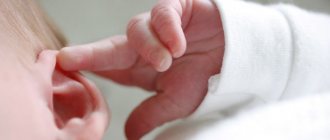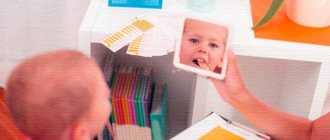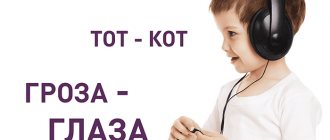Given for a pupil of MBDOU No. 322 – **, born ** ** 2007.
Entered the speech group - 07/08/2015
Diagnosed with level II-III OHP, dysarthria. Intelligence: F 06.827, F 80.1
Sent: for consultation with a psychiatrist.
Revealed:
- speech - pronunciation disorders are noticeable, but the speech is understandable to others;
— speech rate is normal;
- voice – normal;
- mobility of the organs of the articulatory apparatus - “smeared”, compressed, inaccurate;
— performing articulatory movements : the volume of articulatory movements is incomplete. Differentiation and accuracy of movements suffer, range of motion is reduced. There is weakness of the tongue muscles;
- hypoglossal ligament - normal;
— salivation – moderate;
— fine motor skills — weak, require further development; right-handed;
- pronunciation of sounds : whistling parasigmatism, lambdacism, rhotacism;
- phonemic perception - requires further development. Difficulties in the development of sound analysis and synthesis;
- syllable structure - reproduces correctly;
- vocabulary - verb vocabulary is age appropriate. The subject dictionary and the feature dictionary are inaccurate. Experiences difficulties in selecting antonym adjectives;
- grammatical structure of speech - has difficulties in inflection and word formation: the use of the gender form. plural numbers, agreement of nouns with the numerals two and five, formation of relative and possessive adjectives;
- coherent speech - the child can listen and understand speech. Uses simple sentences in speech and answers questions in monosyllables. Can independently compose a sentence based on a picture, or a story based on a series of pictures. Experiences difficulties in composing descriptive stories and retelling short texts; assistance is required in the form of leading and stimulating questions.
In class , he is inactive, slowly gets involved in work, completes tasks slowly, and does not keep up with the overall pace of the group (or subgroup) of children. Can be productive for quite a short time. By the middle of the lesson, there is a decline in performance, lethargy and complete cessation of work.
There is a low level of compensation for the sound aspect of speech during the year of stay in a speech kindergarten.
Speech conclusion : OHP level III, dysarthria.
"30" September 2015
Teacher speech therapist _____________
Head of MBDOU No. _____________
List of speech therapy diseases in children
In children, speech therapy diagnoses come in two forms: physiological and pathological. Unlike pathological ones, physiological types disappear on their own up to 5 years. The sooner the diagnosis is made, the greater the opportunity to correct the preschooler’s speech.
Today, the list of speech therapy diseases for children is quite wide.
The main forms of diseases of the speech system
Dislalia. A preschooler cannot clearly pronounce some sounds with normal hearing and the absence of pathologies in the innervation of the articulatory apparatus. Physiological dyslalia may go away on its own within 5 years. Prevention consists of diligent speech development from 1 year.
Dysarthria is the incorrect pronunciation of words due to poor innervation of the speech apparatus in the posterior frontal and subcortical regions of the brain. Speech is like talking with porridge in your mouth. The cause is damage to the subcortical parts of the brain. Restricted mobility of the tongue and upper palate leads to difficulty in articulation. The pathology is treated with speech therapy methods, exercise therapy, and the development of fine motor skills of the fingers.
Note! Modeling from plasticine and playing with small objects will help here (provided that the parents are with the baby to avoid accidents).
This form of speech therapy disorder in preschool children is accompanied by the collapse of the speech system: impaired speech perception by ear, difficulty in reading and writing. In childhood, dysarthria often leads to impaired pronunciation of words, sometimes to general underdevelopment of speech. Speech deficiencies in dysarthria can be corrected with speech therapy sessions.
Rhinolalia is impaired speech as a result of the presence of congenital pathologies of the oral cavity: cleft lip, cleft palate. In most cases, speech is monotonous and slurred.
Reactive mutism is muteness resulting from nervous stress or psychological shock.
Guidelines for writing characteristics for children with speech impairments for PMPK
Recommendations are drawn up in the form of a small protocol, which indicates the structure of the speech apparatus, hearing assessment, and mental health. As a result, a conclusion is made, the result is displayed and a speech therapy diagnosis is made.
Speech therapy characteristics for a child with level 3 neurodevelopmental disorders at the primary medical complex
Vetvitskaya Anastasia goes to Kindergarten No. 14. Speech is not developed correctly, she cannot pronounce the sounds K, G, D, T. The motor skills of her fingers act passively and do not obey. Parents did not suffer from speech pathology in childhood. The right hand predominates in movements over the left. The facial structure complies with the norms. The task of frowning eyebrows and wrinkled cheeks is poorly performed. Facial muscles are poorly developed.
The structure of the mouth. Language. The root is in a tense state, the tip is passive, flaccid, the general structure corresponds to the norm.
Speech is incomprehensible, monotonous, voice is ringing. In the task to repeat a sentence, he misses syllables and does not pronounce some letters. Has a small vocabulary, misses pronouns in communication, and may confuse prepositions in tense.
Do parents in kindergarten need consultations on speech therapy?
Result: observation showed that the child has a level 3 speech disorder.
Speech therapy characteristics for a child with level 2 neurodevelopmental disorders at primary care
Denis Tukonov is in the senior group, his family is complete, his parents have higher education. The presence of speech pathologies was not identified.
Motor skills are poorly developed, movements are slow, often inhibited.
The anatomical structure of the speech apparatus is without any peculiarities: the structure of the face corresponds to the norm. The milk teeth are being replaced by permanent ones. The hypoglossal ligament is without any features (not stretched, not shortened). There is hypotonicity of the lingual muscle.
Speech is not expressive, sounds are poorly pronounced, and the conversation is incomprehensible to others. The voice is quiet, dull. Facial expressions function poorly.
Hearing from the phonemic level is not sufficiently formed. During a conversation, he mixes unvoiced and voiced sounds. The outline of the word is pronounced unclearly and illegibly.
The structure of speech on a grammatical basis is not well developed. The experiment showed gross underdevelopment of coherent speech. Denis retold 1-2 sentences instead of a full semantic story.
Note! Mental health is normal.
Result: Observation established level 2 speech underdevelopment.
An approximate plan for writing a speech therapy profile for a child with level 4 ODD at the PMPK
Preparatory group, Ksenia Zhuravskaya goes to classes every day, communicates with her peers as best she can. The family is complete and prosperous. There are no speech disorders on the part of the parents. Relatives actively take part in speech development: they conduct independent classes at home.
General motor skills suffer, coordination of movements is impaired, inaccuracies in motor processes and inhibition are noticeable. The right hand is the main one.
The anatomical location of the speaking apparatus in the oral cavity corresponds to the norm. The hypoglossal ligament is normal. The tongue is in tense tone and inactive. The teeth are replaced with molars. When performing articulation tasks, muscle spasms appear. In conversation, syntactic sentence structures are used. Retells the story from pictures independently, using a wide vocabulary. Presents the story accurately and assembles the story logically.
Result: as a result of observation, the commission diagnosed speech underdevelopment as level 4, nvonr.
Speech therapy characteristics of a preschooler with mental retardation
Maria Karnaukhova
Speech therapy characteristics of a preschooler with mental retardation
Speech therapy characteristics of Sergei Ivanov , .... 2012 R
In the 2017-2018 academic year, Sergey Ivanov studied under the senior group program “From birth to school”
(adapted for children with mental retardation)
.
Early speech development lagged behind the age norm.
Articulatory apparatus without pathology. Dental disorders: age-related replacement. Incomplete range of movement of the lips and tongue, difficulty switching, finding an articulatory position. The voice is dull with a nasal tint, the rate of speech is fast. Reflected and independent speech is blurred and not always intelligible. In speech, he does not always differentiate vowel sounds and consonant sounds according to hardness and softness. The sound pronunciation of all groups of consonant sounds is impaired ( "ogets"
(cucumber,
"saik"
(ball,
"bough
beetle,
"grazing"
(cloak,
"mastik"
(ball,
"staynik"
(teapot,
"gola"
(mountain,
"vosat"
(horse,
"medai" (medal) )
.Substitutions for deafness-voicing:
“umbrella”
(umbrella,
“toms” (houses)
.
Phonemic perception is underdeveloped. Sound analysis skills are developing. The syllabic structure of the word is broken: words are abbreviated, consonants are omitted, especially in conjunctions ( “tuytsik”
(chair,
“instruments”
(tools,
“motoist” (motorcyclist)
; adding sounds (
“klyustsi”
(keys,
“sumeka" (bag)
.
The vocabulary almost corresponds to the age norm. Uses generalizing concepts and demonstrates a good level of knowledge about the world around him in classes.
The grammatical structure is at an intermediate level. Uses prepositions in speech. Uses complex, extended phrases. Coherent speech develops. Tries to reason, argue, proving his point of view.
Understanding of spoken speech is impaired. Requires repeated repetitions and sensory support. Average gross and fine motor skills.
High cognitive activity against the background of rapid mood swings and low performance. Requires constant monitoring and frequent changes in the type of activity.
Speech therapy conclusion : Insufficient development of all language means, moderate dysarthria.
Speech therapy correction was carried out in the following areas: development of articulatory and general motor skills, phonemic perception, sound pronunciation skills (sounds of early ontogenesis, whistling sounds, lexico-grammatical structure, sound analysis skills, spatial concepts. The dynamics of classes are positive. It is recommended to continue correctional work in a combined group .
Teacher speech therapist ___
01.10.2018
Speech therapy presentation for PMPK material on speech therapy on the topic
Speech Therapy Presentation
FOR PMPK.
- Speech environment and social conditions:
• There are no neuropsychic, chronic somatic diseases, or speech disorders in parents and close relatives (denied).
- Speech defects in loved ones.
- 2- tongue.
- Hereditary diseases:
- The level of parents is low.
- The upbringing process is under control or not, they are interested in the problems of their child, parents have little communication with the teacher (speech therapist), and do not pay enough attention.
- Not enough attention is paid to appearance.
- Insufficiently developed general social and everyday skills (not
neatly dressed, casually dressed, “dirty”).
- Parents are not interested in the life of the class.
2. State of manual motor skills (range of movements, pace, ability to switch, presence of left-handedness):
- Fine motor skills of the hands are poorly developed.
- There are no impairments of manual motor skills.
- Prefers to work with his left hand (or sometimes works with his left hand)
- The leading ones are the right hand, the right leg, the right eye.
- Head performs tests correctly; with isolated errors, slowly.
- The optical-kinesthetic organization of movements is formed; not sufficiently formed: performs movements with errors, slowly.
- When performing exercises on the dynamic organization of movements, inaccuracies are also observed (synchronous movements of the fingers of the right and left hands).
3. Gross motor skills:
- Impaired switchability of movements (not timely, delayed).
- Associated movements appear.
- Impaired coordination - movements are not performed simultaneously, inaccurately.
- There is a general inhibition of movements.
- Characteristic motor restlessness.
- Slow in movements.
- General coordination is impaired. Clumsy.
4. Articulatory apparatus:
• Anatomical structure of the organs of the articulatory apparatus without
anomalies.
- The structure of the face is not disturbed (disturbed)
- Facial muscle tone is intact or impaired (hypertonicity, hypotonia, dystonia)
- The mobility of the facial muscles is not impaired, impaired
(chin tremor, hypomimia, hyperkinesis).
- The structure of the lips is normal or abnormal (massive lips, the presence of a cleft, the presence of postoperative scars)
- Lip tone is not impaired or impaired (hypertonicity, hypotonia, dystonia)
- Lip mobility is not impaired or impaired –
(sedentary, excessively mobile)
- The structure of the teeth is normal; violations - large, small, rare, frequent, crooked, outside the jaw arch, with large gaps, absence of incisors (lower, upper); presence of extra teeth, dentition disorder.
- The hypoglossal ligament is shortened
- The bite is correct; violated - anterior open, lateral open, prognathia, progenia.
- The structure of the hard palate is not damaged
- The structure of the soft palate and mobility are not impaired
- The structure of the tongue is not damaged.
Abnormalities are noted - thick, small, massive, wide, narrow, forked, shortened frenulum.
- The muscle tone of the tongue is normal; impaired – spasticity, hypotension, dystonia.
The mobility of the tongue is not impaired; disorders - hyperkinesis, tremor, deviation (deviation) of the tongue (to the right, to the left); the tongue is not removed from the oral cavity, the range of articulatory movements is limited; decreased amplitude of articulatory movements, inactive, has difficulty maintaining a posture, has difficulty switching the position of the tongue, movements of the tip of the tongue are impaired. Salivation.
• Speech motor skills are sufficiently developed; within normal limits; not enough. Performs basic articulatory movements with lips and tongue. Movements are slow. Cannot maintain the position of the organs of articulation for a long time. The coordination of movements of the tongue and lips is impaired. The differentiated movements of the tip of the tongue are slightly impaired. The range of movements of the tongue is full; incomplete. The tone is normal; lethargic. The duration of the movements and the tempo of the movements are normal. No substitutions of movements or synkenesis are observed. Synkenesis and movement replacements are noted.
5. Oral speech.
General sound of speech:
- Unintelligible (clear, blurry, difficult to understand for others).
- The rhythm is normal. Excessively stretched.
- Speech rate is slow (fast).
- Expressive.
- Not rushed (excessively fast).
- Little talkative.
- Uses pauses and stress correctly.
- He speaks in monosyllables.
- Makes mistakes due to unformed lexical and grammatical aspects of speech (agrammatism).
- Intonationally inexpressive (or differentiated). Uses basic types of intonation correctly.
- Speech intelligibility is not impaired.
- Speech intelligibility is slightly reduced.
- There is arrhythmia, a slowdown in rhythm at the end of a phrase or text.
- Uses word stress correctly.
- There is no logical stress.
- Uses pauses in speech too often.
- The voice is quiet, strong, sonorous, hoarse, trembling, nasalized.
(Voice (normal volume / loud / quiet / fading / dull / ringing / monotonous, weakly modulated / modulated.)
• Type of breathing is diaphragmatic, speech breathing is smooth; not smooth enough, speech exhalation is long; not long (4-5 words).
6. Speech understanding:
- Difficult, instructions require repeated explanation.
- He understands the speech of others in accordance with his level of intelligence.
- The state of biological hearing according to the medical record is normal.
- The state of speech perception is normal. Correctly performs actions according to verbal instructions.
7. Vocabulary:
- Passive and active vocabulary is characterized by poverty and inaccuracy in the use of many words.
- The use of verbs and adjectives suffers most; generalizing nouns, understanding little-known words (apiary, beehive, waterfall, shoulder straps, hammock, trunk, fountain, boulevard, herbarium, parcel, etc.)
- Limited, poor. Sufficient. Relatively developed.
- Insufficient knowledge about the world around us.
- Familiar with rarely used vocabulary.
- The relations of antonymy and synonymy are unformed.
- Low level of practical generalizations.
- Difficulties in understanding and using vocabulary.
8. Grammatical structure of speech:
a) No violations. No agrammatisms were found in spontaneous speech.
b) Agrammatisms are observed during special research: errors in the use of complex prepositions, in the agreement of adjective and noun, verb and noun.
c) Agrammatisms when forming adjectives from nouns, when forming new words by analogy.
d) Gross violations.
- In speech he uses mainly simple common sentences. In rare cases, complex sentences are noted.
- Makes sentences based on supporting words.
- Complex sentences based on pictures (uses conjunctions - a, but, and).
- Complex sentences are noted only in isolated cases (because; despite; although; when; which; therefore).
- Errors in the use of prepositional-case prepositions, complex prepositions, case endings of plural nouns;
- There are agrammatisms in normal speech; incorrect agreement adj. with noun (The girl has a red dress)
- Incorrect use of prepositional case constructions (The leaves on the trees have turned yellow.)
- There is a misunderstanding and differentiation of constructions with reflexive verbs (the sun illuminates the earth - the sun illuminates the earth)
- Agrammatisms in the formation of adjectives from nouns (blueberry juice).
- Incorrect use of animal names, names of baby animals
- Corresponds to the developmental characteristics of his mental development; children of primary school age.
- Understands and uses prepositions.
- Uses prefixes to form nouns. and ch.
- General poverty and lack of differentiation of the grammatical means of the language.
- primitiveness of syntactic structures.
Types of violations:
- changing nouns by case;
- agreement of nouns with numerals 1,2,5.
- forming the plural of nouns,
- formation of adjectives from nouns,
- formation of prefixed verbs;
- understanding of prepositional-case constructions (others)
11. Phonemic perception (not impaired/impaired), sound analysis and synthesis:
- violations in sound-letter analysis due to insufficient formation of thinking operations (analysis and synthesis).
- Sound differentiation is not impaired. Unsustainable skill. Single or multiple errors. Inability to complete tasks.
- Correctly differentiates the studied sounds by ear or has an unstable auditory differentiation skill (showing pictures - cat kit).
- When reproducing a series of syllables with phonetically similar sounds with errors, he makes isolated errors.
- It is difficult to determine or correctly determine the number and sequence of words in sentences (with conjunctions and prepositions).
- The ability to distinguish a sound from the background of a word has been developed. Determines the presence or absence of a sound in a word, the sequence and number of sounds in a word, its place in a word. Determines the first sound in words correctly, but makes mistakes when determining the last sound. Makes mistakes when identifying sounds in the middle or at the end of a word.
- The ability to determine the place of a sound in a word in relation to other sounds has not been developed. Made numerous mistakes (in the word GOAT the sound “Z” is heard before the sound “K”)
- There are difficulties in differentiating hard and soft, voiced and voiceless sounds.
- Phonemic synthesis has been formed. Correctly reproduces words from the sequential names of sounds (r-u-k-a, s-t-a-k-a-n, pasta, crow).
- Phonemic representations are sufficiently formed, insufficiently formed, or not formed. Comes up with words for given sounds, selected pictures with 5 sounds in the name. However, he made isolated mistakes in the task of coming up with words of 5 sounds.
10. State of language analysis and synthesis
Correctly/incorrectly determines the sequence and number of words in sentences with prepositions: “Katya is going for a walk” (2). “There is a book on the table” (3). “Children are skating” (5). “It can be very hot in summer” (3), etc.
Made mistakes when determining the sequence of words in a sentence. In the sentence “there was a blue vase on the table,” the word “vase” comes after the word “table,” etc.
The synthesis is not disrupted. Correctly composes sentences from sequentially given words.
11. State of sound pronunciation
- Monomorphic disorder of sound pronunciation: velar rotacism/
lateral sigmatism of sibilants/ uvular rhotacism.
- Currently, there are no problems with sound pronunciation. Sound pronunciation is not impaired.
- Polymorphic disorder of sound pronunciation: lateral sigmatism of sibilants, lateral rhotacism.
12. Sound-syllable structure of speech:
- Safe. There are no violations of the sound-syllable structure of the word. In spontaneous speech, the sound-syllable structure of the word is not disrupted.
- Correct reproduction of words of different syllable structures.
- Inability to reproduce words.
- Impairment in phrasal speech; rearranges or increases syllables; substitutions, omissions, repetitions.
- Makes isolated mistakes when reproducing little-known four-syllable words with consonant clusters (mainly assimilations, simplifications of consonant clusters, omission of syllables).
Pronunciation of words with complex syllabic composition.
- reduction of consonant groups: ( +/ - )
- Stopping the sound of a consonant at the end of a word: ( +/ — )
- Dropping the initial consonant: ( +/ — )
- adding an extra consonant to a syllable: ( +/ — )
- rearrangement of sounds in a word: ( +/ -)
- syllable assimilation: ( +/ — )
- reduction in the number of syllables: ( +/ - )
- adding the number of syllables: ( +/ — )
13. State of visual function
1) The state of biological vision according to the medical card is normal.
2) State of higher visual-spatial functions:
a) the body diagram is formed;
b) correctly determines the location of objects (right or left);
c) he did not perform all of Head’s tests correctly (difficulties in determining the right and
left parts of the body of the person sitting opposite);
d) correctly compiled pictures cut into 6-8 parts, starting with 8
made isolated mistakes;
e) the construction of figures from sticks according to the model is not impaired. Difficulty
design and reconstruction of geometric figures according to
presentation. According to verbal instructions, I couldn’t cope with many
tasks.
3) State of speech-visual functions (according to the album of optical and visual
tests): names all printed and handwritten letters correctly.
Recognizes shaded, superimposed, unfinished,
letters written in mirror and dotted lines, graphically similar letters.
The construction of letters is generally correct, allowing only
isolated errors.
Makes mistakes in reconstructing letters from elements.
The idea of the structure of the visual image of handwritten letters is impaired (cannot verbally explain what elements the letter “v” consists of, how “t” and “p” differ).
14. A story based on a series of plot pictures
Criterion of semantic integrity
|
|
|
|
2) The criterion for the lexical and grammatical format of a statement.
| The story is grammatically correct with adequate use of lexical means. |
| The story is written without ungrammaticalisms, but there is stereotypical grammatical design, isolated cases of missing words or incorrect word usage. |
| There are agrammatisms, distant verbal substitutions, and inadequate use of lexical means. |
| The story is not finalized. |
- Retelling the text you listened to
Peas.
There were peas in one pod. A week has passed. The pod opened and the peas merrily rolled out into the boy’s palm. The boy loaded the gun with peas and fired. Three peas flew onto the roof. There they were eaten by pigeons. And one pea rolled into a ditch. She sprouted. Soon it turned green and became a curly pea bush.
- Criteria of semantic integrity.
| All semantic links are reproduced |
| Semantic links are reproduced with minor abbreviations |
| The retelling is not complete, there are significant abbreviations or distortions of meaning, or the inclusion of extraneous information. |
| Failure to comply. |
2) Criteria for lexico-grammatical format
| The retelling was compiled without violating lexical and grammatical norms. |
| The retelling does not contain agrammatisms, but there is a stereotypic design of the statement, a search for words, and some close substitutions. |
| Agrammatisms, repetitions, and inadequate use of words are noted. |
| Retelling not available. |
3) Criteria for independent implementation.
| Independent retelling after the first presentation. |
| Retell after minimal help (1-2 questions) or after re-reading. |
| Retelling the questions. |
| Even for questions, retelling is not available. |
16. Characteristics of reading.
1. Reading technique:
- Letter by letter
- Syllabic
- Age appropriate/inappropriate
- Automated/non-automated
- Breathing while reading:
- Right/Wrong
- With intonations
- Breathing rhythm disturbance.
- Expressiveness.
- Monotonous/expressive.
- Reading comprehension.
In full / difficult.
14. Characteristics of the letter.
- No spelling errors.
- When copying, errors (single, multiple) are (not) observed.
- There are numerous errors in dictations and presentations.
- Graphic errors: missing elements or extra elements. The difficulty is in orientation on the notebook sheet, in finding the beginning of the line. Difficulty holding a line. Constant fluctuations in the inclination and height of letters, inconsistency of letter elements in size, separate writing of letters within a word. Difficulties in updating the graphic and motor image of the desired letter, replacing visually similar and closely written letters (K - N), replacing handwritten letters with printed ones, an unusual way of writing letters, especially capital ones. Consistent specularity when writing the letters Z, E, E, S. Replacement of letters U - Ch, d-b, d-v.
- The impossibility of creating the skill of ideogram writing (“class robot”, “exercise”, “keno” instead of “cinema”).
- Specific errors: perseveration (inert repetition) of letters, syllables, words, types of tasks; omissions of letters and syllables; anticipation (anticipation) of letters, for example, “poklovok” - float; contamination (sticking together) of words. Lack of emphasis at the beginning of the sentence. Omission and replacement of vowels, including stressed ones. Violation of the order of letters. Tendency towards phonetic writing (“radono” instead of “joyfully”, “ruchyi” - “streams”)
Difficulties in isolating a holistic image of a word, as a result of which two significant words, words with prepositions are written together; later, due to overgeneralization of the rules for writing prepositions, prefixes are written separately from the roots.
- Spelling mistakes
- The ability to check has not been developed (does not check; if it checks, it does not see errors / does not see errors or corrects incorrectly).
- The writing pace is slow.
Conclusions:
- First half of 1st grade: difficulties in mastering writing. They manifest themselves in unclear knowledge of the letters of the alphabet, difficulties in translating a phoneme into a grapheme, and in translating a printed grapheme into a written one.
- Second half of first grade or beginning of 2nd grade: disruption of the formation of writing processes. Manifestations: replacement and mixing of written and printed letters according to various criteria, difficulty in merging letters, syllables, syllables into words, writing words without vowels, fused writing of several words or separate spelling of words.
- Second half of 2nd year of study – dysgraphia.
Third year of study – dysorthography. Manifestations: a large number of spelling errors, inability to apply spelling rules according to the school curriculum for the corresponding period of study.
Conclusion for the ZPR:
- (1 CL.) Reading and writing impairment caused by OHP (FFN, FN).
- The pace of smoothness is of a convulsive (non-judicial) nature.
- (2-3 grades) Residual phenomena of insufficient development of language means at the level of oral and written speech.
- (recommission) Reading and writing disorders caused by insufficient development of language means, with a predominance of inferiority of the sound or semantic side of speech.
- A speech therapy report can be:
- FNR,
- FFNR,
- ONR-3,
- NVONR,
- LGNR,
- sound pronunciation is normal, speech is within the age norm.
Recommendations:
Based on pedagogical observations and problems in the educational process, I request a consultation with a neuropsychiatrist.
Areas of speech correction work recommended on the basis of a diagnostic speech therapy examination.
(highlight the directions carried out during the correction course; circle all the areas of work necessary for the patient).
1. Development of auditory perception.
- Development of phonemic analysis and synthesis (discrimination of consonants based on the characteristics of voiced/voiceless, place of formation, hardness/softness;
determination of phoneme in a word/phonemic composition of words; naming words with a given phoneme.
3.Development of speech breathing, practicing oral and nasal exhalation.
4.. Stimulation of the velopharyngeal closure, activation of articulation, development of mobility of the articulatory apparatus.
5. Work on the voice (removing nasalization, developing intonation expressiveness, speeding up / slowing down the rate of speech, developing a soft voice).
6. Correction of sound pronunciation: ________________________
7. Education of kinesthesia necessary for speech.
8. Development of passive and active vocabulary (nouns, verbs, adjectives).
9. Development of the grammatical structure of speech.
10. Development of speech understanding.
11. Development of auditory-visual attention.
12. Development of memory (auditory, verbal, visual).
13. Formation of cognitive skills (discrimination of shape, color, number of objects).
14. Formation of elementary mathematical concepts.
15. Development of gross/fine motor skills.






